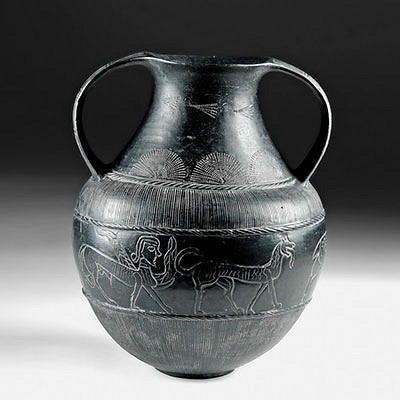Nayarit San Sabastian Bi-Chrome Seated Warrior Figure
Lot 101a
About Seller
Artemis Gallery
686 S Taylor Ave, Ste 106
Louisville, CO 80027
United States
Selling antiquities, ancient and ethnographic art online since 1993, Artemis Gallery specializes in Classical Antiquities (Egyptian, Greek, Roman, Near Eastern), Asian, Pre-Columbian, African / Tribal / Oceanographic art. Our extensive inventory includes pottery, stone, metal, wood, glass and textil...Read more
Estimate:
$3,000 - $4,500
Absentee vs Live bid
Two ways to bid:
- Leave a max absentee bid and the platform will bid on your behalf up to your maximum bid during the live auction.
- Bid live during the auction and your bids will be submitted real-time to the auctioneer.
Bid Increments
| Price | Bid Increment |
|---|---|
| $0 | $25 |
| $300 | $50 |
| $1,000 | $100 |
| $2,000 | $250 |
| $5,000 | $500 |
| $10,000 | $1,000 |
| $20,000 | $2,500 |
| $50,000 | $5,000 |
| $100,000 | $10,000 |
| $200,000 | $20,000 |
About Auction
By Artemis Gallery
Sep 17, 2020
Set Reminder
2020-09-17 10:00:00
2020-09-17 10:00:00
America/New_York
Bidsquare
Bidsquare : CLEARANCE - Ancient, Pre-Columbian, Ethno Art
https://www.bidsquare.com/auctions/artemis-gallery/clearance---ancient-pre-columbian-ethno-art-5605
End-of-Summer Clearance sale featuring discounted pricing on antiquities from Egypt, Greece, Italy, and the Near East...plus Viking, Asian, Pre-Columbian, Tribal, Russian Icons, Spanish Colonial, Fine Art, more! Starting prices have been reduced up to 65% from original auction prices. Artemis Gallery info@artemisgallery.com
End-of-Summer Clearance sale featuring discounted pricing on antiquities from Egypt, Greece, Italy, and the Near East...plus Viking, Asian, Pre-Columbian, Tribal, Russian Icons, Spanish Colonial, Fine Art, more! Starting prices have been reduced up to 65% from original auction prices. Artemis Gallery info@artemisgallery.com
- Lot Description
**Originally Listed At $1900**
Pre-Columbian, West Mexico, Nayarit, San Sebastian type, ca. 100 BCE to 250 CE. A sizeable polychrome - orange and white with black outlines - seated male warrior figure with legs crossed at the ankles, his right arm raised and his left arm extended outward from his body just a tad. Topped by a crested coiffure or helmet, his cream-hued visage is quite expressive, presenting large almond-shaped eyes, an arched browline, a pronounced nose with delineated nostrils, an open mouth as if speaking, chanting, or singing, nicely contoured facial planes with faint black striations (indicating tattoos or face paint) across the cheeks, and an incised short coiffure. He wears a painted cream shirt having an over the right shoulder strap and cream-hued leg wraps. Otherwise his body is nude, revealing male genitalia. In addition to the head crest, he is bedecked with fancy ear ornaments and a double coiled necklace with partial perforations to decorate it. Size: 10.375" L x 9.625" W x 17.75" H (26.4 cm x 24.4 cm x 45.1 cm)
West Mexican shaft tomb figures like this example derive their names from the central architectural feature that we know of from this culture. Nayarit, located on Mexico's southwest coast, was part of the shaft tomb culture during this time, along with neighbors in nearby Colima and Jalisco. These indigenous peoples would build generally rectangular vertical or near-vertical shafts down from the ground level - usually about 3 to 20 meters deep - through tepetate, the volcanic tuff that makes up the geology of the region, to narrow horizontal tunnels that led to one or more vaulted or rounded burial chambers.
These shafts were almost always dug beneath a dwelling, probably a family home, and were used as family mausoleums, housing the remains of many related individuals. Figures like this one were placed into the tombs; researchers believe that they were placed around the edges facing inward, as if in conversation with the dead. Grouped with other figures, and alongside clay bowls, and boxes, figures like this one were positioned around the body (or bodies), near the skull.
This piece has been tested using thermoluminescence (TL) analysis and has been found to be ancient and of the period stated. A full report will accompany purchase
Provenance: ex-private Howard Rose Gallery, New York, New York, USA; ex-private collection, California, USA; ex-Jim Bodisbaugh collection
All items legal to buy/sell under U.S. Statute covering cultural patrimony Code 2600, CHAPTER 14, and are guaranteed to be as described or your money back.
A Certificate of Authenticity will accompany all winning bids.
We ship worldwide and handle all shipping in-house for your convenience.
#150158Repaired from approximately fifteen pieces with restoration over the break lines. Left arm repaired and reattached, break lines visible, two toes reattached with minute losses to tips of fingers and toes. Scattered mineral deposits on the surface.Condition
- Shipping Info
-
All shipping is handled in-house for your convenience. Your invoice from Artemis Gallery will include shipping calculation instructions. If in doubt, please inquire BEFORE bidding for estimated shipping costs for individual items.
-
- Buyer's Premium



 EUR
EUR CAD
CAD AUD
AUD GBP
GBP MXN
MXN HKD
HKD CNY
CNY MYR
MYR SEK
SEK SGD
SGD CHF
CHF THB
THB














